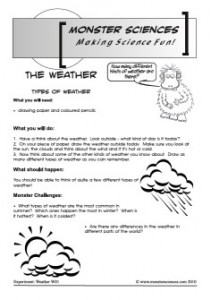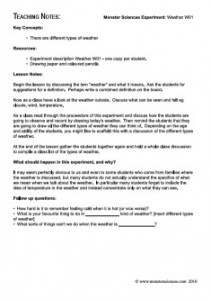This weather science experiment is ideal for even young students to learn all about the different types of weather, making observations and collecting data.
 |
 |
Weather Science Experiment: Types of Weather
What you will need:
• drawing paper and coloured pencils
What you will do:
1. Have a think about the weather. Look outside – what kind of day is it today?
2. On your piece of paper, draw the weather outside today. Make sure you look at the sun, the clouds and think about the wind and if it’s hot or cold.
3. Now think about some of the other kinds of weather you know about. Draw as many different types of weather as you can remember.
What should happen:
You should be able to think of quite a few different types of weather!
Monster Challenges:
• What types of weather are the most common in summer? Which ones happen the most in winter? When is it hottest? When is it coldest?
• Are there any differences in the weather in different parts of the world?
Teaching Notes: Monster Sciences Experiment: Weather W01
Key Concepts: • There are different types of weather
Resources:
• Experiment description Weather W01 – one copy per student.
• Drawing paper and coloured pencils
Lesson Notes:
Begin the lesson by discussing the term “weather” and what it means. Ask the students for suggestions for a definition. Perhaps write a combined definition on the board. Now as a class have a look at the weather outside. Discuss what can be seen and felt eg clouds, wind, temperature.
As a class read through the proceedure of this experiment and discuss how the students are going to observe and record by drawing today’s weather. Then remind the students that they are going to draw all the different types of weather they can think of. Depending on the age and ability of the students, you might like to scaffold this with a discussion of the different types of weather.
At the end of the lesson gather the students together again and hold a whole class discussion to compile a class list of the types of weather.
What should happen in this experiment, and why?
It may seem perfectly obvious to us and even to some students who come from families where the weather is discussed, but many students do not actually understand the specifics of what we mean when we talk about the weather. In particular many students forget to include the idea of temperature in the weather and instead concentrate only on what they can see.
Follow up questions:
• How hard is it to remember feeling cold when it is hot (or vice versa)?
• What is your favourite thing to do in ______________ kind of weather? [insert different types of weather]
• What sorts of things can’t we do when the weather is _______________?
© www.monstersciences.com



